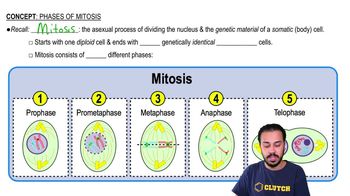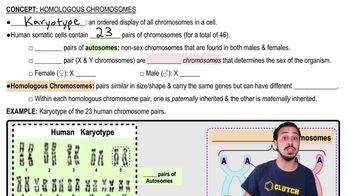Which of the following occurs during S phase? (A) condensation of the chromosomes (B) replication of the DNA (C) separation of sister chromatids (D) spindle formation
Ch. 12 - The Cell Cycle
Chapter 12, Problem 9
VISUAL SKILLS The light micrograph shows dividing cells near the tip of an onion root. Identify a cell in each of the following stages: prophase, prometaphase, metaphase, anaphase, and telophase. Describe the major events occurring at each stage.
 Verified step by step guidance
Verified step by step guidance1
Identify each stage by examining the arrangement and appearance of chromosomes and the spindle fibers. In prophase, look for cells where chromatin condenses into visible chromosomes and the nuclear envelope begins to break down. Spindle fibers start to form.
In prometaphase, identify cells where the nuclear envelope is completely dissolved, and chromosomes are more condensed. Spindle fibers attach to the kinetochores of chromosomes.
For metaphase, find cells where chromosomes are aligned at the metaphase plate (equatorial plane) of the cell, with spindle fibers attached to the kinetochores of the chromosomes.
In anaphase, look for cells where sister chromatids are separating and moving towards opposite poles of the cell, pulled by the spindle fibers.
For telophase, identify cells where chromosomes arrive at the poles and begin to decondense, nuclear envelopes re-form around each set of chromosomes, and the spindle fibers disassemble. This stage is followed by cytokinesis, where the cell divides into two.

Verified Solution
Video duration:
1mWas this helpful?
Key Concepts
Here are the essential concepts you must grasp in order to answer the question correctly.
Mitosis
Mitosis is the process of cell division that results in two genetically identical daughter cells from a single parent cell. It consists of several stages: prophase, prometaphase, metaphase, anaphase, and telophase, each characterized by specific events that ensure the accurate distribution of chromosomes. Understanding mitosis is crucial for identifying the stages in dividing cells, such as those in an onion root tip.
Recommended video:
Guided course

Phases of Mitosis
Chromosome Structure
Chromosomes are structures within cells that contain DNA and proteins, and they play a vital role during cell division. Each chromosome is made up of two sister chromatids joined at a region called the centromere. During mitosis, the organization and alignment of chromosomes are critical for their proper segregation, making it essential to recognize their structure when identifying stages of mitosis.
Recommended video:
Guided course

Homologous Chromosomes
Cell Cycle Regulation
The cell cycle is regulated by a series of checkpoints that ensure the cell is ready to proceed to the next phase of division. These checkpoints monitor DNA integrity, chromosome alignment, and cell size, preventing errors that could lead to abnormal cell division. Understanding cell cycle regulation helps explain the importance of each mitotic stage and the consequences of errors during these processes.
Recommended video:
Guided course

Cell Cycle Regulation
Related Practice
Textbook Question
1731
views
Textbook Question
Cell A has half as much DNA as cells B, C, and D in a mitotically active tissue. Cell A is most likely in a. G1. b. G2. c. prophase. d. metaphase.
1952
views
Textbook Question
The drug cytochalasin B blocks the function of actin. Which of the following aspects of the animal cell cycle would be most disrupted by cytochalasin B? a. spindle formation b. spindle attachment to kinetochores c. cell elongation during anaphase d. cleavage furrow formation and cytokinesis
1760
views
Textbook Question
DRAW IT Draw one eukaryotic chromosome as it would appear during interphase, during each of the stages of mitosis, and during cytokinesis. Also draw and label the nuclear envelope and any microtubules attached to the chromosome(s).
1131
views
